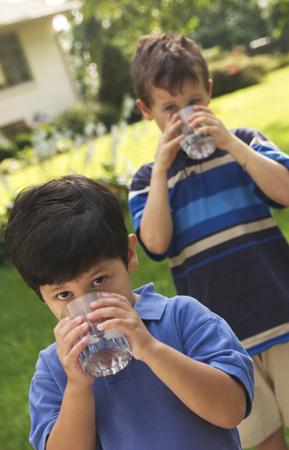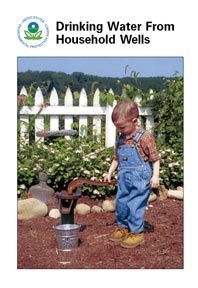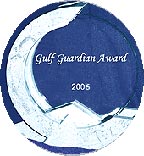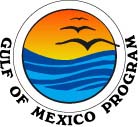Water Quick Finder
- Water Home
- Animal Waste
- Coastal Louisiana
- Source Water Assessment
- Publications
- Mexico Border Projects
- Educator Resources
- Septic Systems
- Stormwater
- Tribal Water Protection
- Underground Injection Wells
- Water Conservation
- Homeland Security
- More...
Water
 The Water Quality Protection Division of EPA Region 6 focuses its resources on protecting and preserving the aquatic ecosystems and water
resources of Arkansas, Louisiana, New Mexico, Oklahoma, and Texas, as well as the Tribal lands located within our region. Our vision is to provide leadership and
assistance to support protection and restoration efforts so that all waters in Region 6 meet all designated uses, and all citizens have access to safe drinking water. Working
together, we will aggressively pursue our vision.
The Water Quality Protection Division of EPA Region 6 focuses its resources on protecting and preserving the aquatic ecosystems and water
resources of Arkansas, Louisiana, New Mexico, Oklahoma, and Texas, as well as the Tribal lands located within our region. Our vision is to provide leadership and
assistance to support protection and restoration efforts so that all waters in Region 6 meet all designated uses, and all citizens have access to safe drinking water. Working
together, we will aggressively pursue our vision.
Making beaches fun now, and in the future
It’s a good bet that, as the school year winds down, your vacations plans will include a trip to the beach. That’s because Americans log almost two billion trips to the seaside every year. Our country’s Atlantic and Pacific Ocean coasts, Gulf of Mexico region and Great Lakes provide endless outdoor fun for so many families. The surf and sand can be even more enjoyable if you take care of your surroundings during your visit. More
Clean Water Act turns 35
October is a special month for America’s waters, wetlands, and watersheds. On October 18, the Clean Water Act turned 35.
EPA remains committed to working with our partners to help change the way America views and values water and the infrastructure support systems. Read more ...>
Torreon Wash project selected for EPA grant
A project to improve the Torreon Wash has been selected as one of 16 national finalists eligible to apply for more than $13 million in available grants from the Environmental Protection Agency. Read more…>
New Storm Water Protection Video

EPA has released a new Spanish-language video, Chucho Salva el Dia (Chucho Saves the Day), designed to help children understand the importance of storm water protection in daily life. Read more ... >
 Household Drinking Water Wells
Household Drinking Water Wells
If your family gets drinking water from a private well, do you know if your water is safe to drink? What health risks could you and your family face? Where can you go for help or advice? This pamphlet helps answer these questions. It gives you general information about drinking water from home wells.
Download a copy of the pamphlet
Get additional information on private wells
Gulf Guardians recognized for protecting environment
 EPA and its Gulf of Mexico Program recently presented awards to recognize innovative efforts to improve the environmental and economic health of the Gulf of Mexico.
EPA and its Gulf of Mexico Program recently presented awards to recognize innovative efforts to improve the environmental and economic health of the Gulf of Mexico.
“The issues affecting the Gulf Coast are among the  most dynamic and variable that the nation faces, and the collaborating partners who address these issues daily exhibit the diverse range of skills needed to advance environmental protection in the region,” EPA Regional Administrator Richard E. Greene said. Read more …>
most dynamic and variable that the nation faces, and the collaborating partners who address these issues daily exhibit the diverse range of skills needed to advance environmental protection in the region,” EPA Regional Administrator Richard E. Greene said. Read more …>
New EPA Program Saves Dollars and Makes Sense
WaterSense will educate American  consumers on making smart water choices that save money and maintain high environmental standards without compromising performance. Read more ...>
consumers on making smart water choices that save money and maintain high environmental standards without compromising performance. Read more ...>
Learn more about WaterSense | News Release | en español
Major Collaborative Effort Gives Tribe Clean Water
All fourteen of the New Mexico Mescalero Apache Tribe's water systems now produce clean drinking water for the first time in fifteen years. This achievement is the result of a major, long-term collaborative effort involving the tribe, EPA Headquarters and Region 6, and the Indian Health Service.
The Region 6 tribal enforcement process worked so well that EPA plans to apply it in other regions. Regional staff involved in the process received an Outstanding Interagency Cooperation Award for their efforts, and tribal members received an EPA award.
All Mescalero systems at times had been cited for coliform levels above Safe Drinking Water Act standards and for failing to sample and monitor water quality. The tribe also had no certified system operators. Efforts to solve this long-standing problem began with dialogue between tribal officials and EPA's Enforcement Division.
EPA then issued three Consent Orders requiring the installation and operation of continuous chlorination systems, with follow-up monitoring and operator certification. All agencies and tribal officials worked hard on long-term technical and compliance solutions.
Many capital improvements were made to the systems. The tribe now has a high-level certified operator. Regular sampling and monitoring has been done, and no Total Coliform Rule violations have been reported for more than two years. All systems work well.
For more information:
Public drinking water supply meets high standards of safety and purity
The public drinking water supply in the United States is one of the safest in the world, thanks to the high standards set by EPA under the Safe Drinking Water Act. Collaborative efforts with state drinking water authorities and thousands of public drinking water systems ensure that drinking water in Region 6 continues to meet or exceed these stringent standards.
Reports for the first half of 2005 show that ninety-five percent of the population in Region 6 drinks water that meets the latest standards, which is well above the seventy-five percent initial goal for the year. "We are encouraged by these results, and expect them to continue at high levels," said Blake Atkins, chief of the Region 6 Drinking Water Section.
The EPA continues to help advance the science and technology that will keep delivering the purest water possible, through the efforts of EPA's Office of Research and Development and grants to universities and foundations. Regular inspections help ensure compliance with the rules, so that water systems meet standards for chemical, radiological and microbiological contaminants as they continue to deliver a safe supply of public drinking water.
Post-Hurricane Drinking Water Update
Consumer safety from public drinking water systems in hurricane-damaged areas is ensured by timely public service announcements regarding drinking water quality, and then by thorough inspections and bacteriological analysis before systems are allowed to resume operations.
As of November 4, 2005, ninety-five percent of Louisiana public water systems are serving ninety-eight percent of the population without a boil water advisory. In Texas areas impacted by Hurricane Rita, eighty-two percent of the systems, serving ninety-five percent of the people, were operating without boil advisories.
Public systems, including those operating in areas hit by the hurricanes, still produce one of the safest drinking water supplies in the world.
For more information:
Back to the Region 6 home page
EPA/Louisiana ties strengthened before Hurricanes
While many public drinking water systems in Louisiana suffered Hurricane damage, efforts to restore systems to full, safe operation were strengthened by the state's effective partnership with EPA. A few months before Hurricanes Katrina and Rita hit, EPA had approved four state-adopted regulatory packages, updating Louisiana primacy over all state-regulated water systems, in conformity with EPA regulations. Both Louisiana and Texas originally received primacy in 1977, and have continued to work closely with EPA ever since
 Drinking
Water and Health: What you need to know
Drinking
Water and Health: What you need to know
The United States has one of the safest water supplies in the world. However, national statistics don't tell you specifically about the quality and safety of the water coming out of your tap. That's because drinking water quality varies from place to place, depending on the condition of the source water from which it is drawn and the treatment it receives.
Now you have a new way to find information about your drinking water, if it comes from a public water supplier. (EPA doesn't regulate private wells, but does have recommendations for their owners.) Every community water supplier must provide an annual report (sometimes called a consumer confidence report) to its customers. The report provides information on your local drinking water quality, including the water's source, the contaminants found in the water, and how consumers can get involved in protecting drinking water. Read more >
EPA report commends Louisiana wetlands achievements
EPA commends the Louisiana Department of Natural Resources for its collaborative efforts with landowners and others to help protect and restore the state's coastal marshes. This commendation is just part of the information in the Agency's new four-page report covering 2002 and 2003 activities in Louisiana under the Louisiana Coastal Wetlands Conservation Plan.
The EPA believes Louisiana is meeting the Coastal Wetlands Conservation Plan goal --- no net loss of coastal wetlands resulting from permits issued for development activities since Plan approval. "Saving Louisiana's coast is one of our highest priorities," said Regional Administrator Richard Greene. "Together with our partners, we are hard at work completing ongoing projects and beginning new ones to restore, improve and protect this valuable treasure. We look forward to the success of these continuing efforts being highlighted in the next report."
The Plan is a vital part of broad state and federal efforts to protect and restore Louisiana's coastal wetlands and barrier islands, a nationally significant natural resource. The report, required under the Coastal Wetlands Planning, Protection and Restoration Act, also contains EPA recommendations for future actions to preserve these vital parts of our environment.
The wetlands and barrier islands support the largest fishery in the continental U.S., provide critical habitat for a wide range of birds, and help coastal communities better weather storm surges.
View the plan in PDF format (30 pp., 1465KB).
EPA and its environmental partners celebrate the 15th annual
American Wetlands Month this May. The 2005 theme, "It
Pays to Save Wetlands," focuses on the economic benefits
that wetlands provide, and the success over the past year.
On Earth Day 2005, the President announced that approximately
832,000 acres of wetlands have been preserved in the first
year of his five-year commitment to create, improve and protect
at least three million wetland acres. Read
more >
To learn more, visit the Wetlands Web site.
Wetland conservationists honored with national awards
Seven wetlands educators, scientists and conservationists will receive National Wetlands Awards Wednesday, May 18, 2005 at a Capitol Hill presentation. Two of the honored seven live and work in EPA Region 6 states. The Awards are announced during the Agency's annual American Wetlands Month in May. They celebrate people who have demonstrated extraordinary dedication, innovation or excellence in wetlands conservation and protection of valuable aquatic resources.
Tom Foti, of the Arkansas Natural Heritage Commission in Little Rock, Arkansas, won in the State, Tribal & Local Program Development category. His 30-year career has greatly impacted Arkansas wetlands. His work at the Arkansas Ecology Center helped save the Cache River from being channeled. Tom also worked with the EPA to improve and subdivide Arkansas eco-regions to better reflect Arkansas wetland diversity.
Winner in the Wetland Community Leader category is Hazel Sinclair of Covington, Louisiana. Hazel, a high school biology teacher, produced a documentary film exploring the role of the alligator ranching industry in wetland preservation. She also led an effort to protect a pristine wetland from development, and the landmark federal court ruling that reversed the wetland permit for the 200-acre subdivision set a precedent for future court challenges for wetlands.
Awards program co-sponsors are EPA, the Environmental Law Institute, the U.S. Fish and Wildlife Service, the U.S. Forest Service, the U.S. Natural Resources Conservation Service, Federal Highway Administration and National Oceanic and Atmospheric Administration Fisheries.
Joint-agency Environmental Law Institute news release on Tom Foti in PDF format (1 pp., 96KB).
Joint-agency Environmental Law Institute news release on Hazel Sinclair in PDF format (1 pp., 101KB).
For more information, visit the National
Wetlands Awards Web site.

 Timbalier
Island project helps save coastal marshes
Timbalier
Island project helps save coastal marshes Preserving wetlands is vitally important to all of us. This is especially true in the nation's coastal marshes. We rely on these areas for recreation, for wildlife habitats and nurseries, to clean water and to help replenish the water in underground aquifers.
Nowhere is the challenge to preserve coastal marshes greater than in Louisiana, where 90 per cent of the nation's marsh losses are occurring. More than 1,500 square miles of land have disappeared into open water. By 2050 a full third of the state could vanish into the Gulf of Mexico.
The EPA is working with other agencies and citizen groups on a project to rebuild barrier islands. Timbalier Island was completed in late December 2004, some $3.5 million under budget despite extra work needed to repair damage from Hurricane Ivan.
Timbalier Island, 35 miles southwest of Houma, was in real danger of disappearing. Nearly five million cubic feet of sand were pumped onto the island to create a dune and marsh. More than 20,000 plants were placed to help prevent erosion. The beach is growing, beyond the boundaries of the work area, and the island is again supporting a diverse fishery and is teeming with nesting migratory water birds. The restoration of Timbalier Island will also give coastal communities and wetlands a new measure of protection from future storms.
Additionally, EPA, the Corps of Engineers and the Louisiana Department of Natural Resources developed a comprehensive plan to restore coastal marshes and wetlands.
For information about other projects in Louisiana, visit the EPA Coastal Restoration Web site.
For information about protecting our coastlines, visit the EPA Oceans, Coasts and Estuaries Web site.
Coastal Wetlands Planning, Protection and Restoration Act
Approximately 40 % of the U.S. Coastal Wetlands is located in Louisiana. The coast is a fragile environment, and Louisiana has lost up to 40 square miles of marsh a year for several decades. If the current loss rate continues, an additional 800,000 acres of wetlands in Louisiana will disappear. These facts prompted Congress to pass the Coastal Wetlands Planning, Protection and Restoration Act (CWPPRA) in 1990. It funds wetland enhancement projects nationwide, designating approximately $35 million annually for work in Louisiana. Read more >
The NPDES program regulates the discharge of pollutants from point sources to waters of the United States. Concentrated Animal Feeding Operations (CAFOs) are point sources, as defined by the CWA [Section 502(14)]. To be considered a CAFO, a facility must first be defined as an Animal Feeding Operation (AFO).
Animal Feeding Operations (AFOs) are agricultural operations where animals are kept and raised in confined situations. AFOs generally congregate animals, feed, manure, dead animals, and production operations on a small land area. Feed is brought to the animals rather than the animals grazing or otherwise seeking feed in pastures. Animal waste and wastewater can enter water bodies from spills or breaks of waste storage structures (due to accidents or excessive rain), and non-agricultural application of manure to crop land. AFOs that meet the regulatory definition of a concentrated animal feeding operation (CAFO) have the potential of being regulated under the NPDES permitting program. Read more >
Concentrated Animal Feeding Operations - Forms and Documents

Resources
- Region 6 Public Information Center (800) 887-6063
- About Region 6
- Federal Register
- Contact Us
- Freedom of Information Act
- Employee Access
Featured Sites
Featured Sites
- Region 6 NPDES Public Notices
- EPA Office of Water
- View information about surface water features and their environmental condition.
- National EPA Water topics
- EPA's Strategic Plan for Water
Additional Information
Air, Agriculture, Brownfields, Cleanup, Ecosystems, Enforcement, Environmental Justice, Grants, Laboratory, Pesticides, Superfund, Tribal, Training, Waste, Water, more topics
![[logo] US EPA](https://webarchive.library.unt.edu/eot2008/20081105213441im_/http://www.epa.gov/epafiles/images/logo_epaseal.gif)

